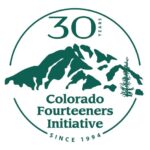Recommended Route
Yankee Boy Basin Route—use of this route will help to reduce impacts to this Fourteener’s fragile alpine environment. For detailed route information including pictures, maps, and elevation profiles, click here.
Route Information and Additional Resources
South of Ouray, CO leave US 550 and go west on Colorado 361 for 7 miles to the old town of Sneffels. Hike the continuing rough jeep road from the town of Sneffels into the upper Yankee Boy Basin. The route travels through Yankee Boy Basin and cuts off north from the Blue Lakes Pass Trail. The final approach is up a couloir on the southeast side of Sneffels.
The above information does not replace the need to consult additional maps and Colorado Fourteener Guidebooks for more detailed route descriptions. We suggest checking multiple resources before departing on any hike. Keep in mind that not all guidebooks list this recommended route and that each guidebook’s description or route name may vary slightly.
Peak Specific Environmental and Safety Concerns
Much of the land in Yankee Boy Basin is privately owned. Respect the rights of these landowners. Camping is not allowed on private land unless written permission has been obtained from the owners. Camping is allowed at the Amphitheater Campground in Ouray, Ridgeway State Park, and various other campgrounds in Ouray and Ridgeway. Dispersed camping is available along Canyon Creek southwest of Ouray. Protect the historic mining structures on these lands.
Minimize Campfire Impacts. Open fires are discouraged, especially in Yankee Boy Basin where wood is scarce. Campfires are prohibited in the Blue Lakes drainage of the Mount Sneffels wilderness.
Yankee Boy Basin is a popular jeep tour area. At times parking areas can be congested. Car-pooling is recommended. Drive or park only on roads and previously impacted parking sites.
Properly dispose of human waste. There is one composting toilet available for use along the road into Yankee Boy basin. If unable to use the toilet, please use proper Leave No Trace practices (i.e. below timberline, bury waste in a “cat hole” and pack out toilet paper. Above timberline, pack out all solid human and dog waste).
Plan for highly variable weather and exercise safety around other climbers. Be cautious of rolling rocks.


